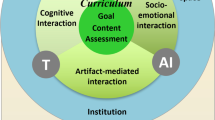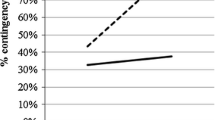Abstract
School–university partnerships (SUPs) are considered a way of improving teacher education. For the successful implementation of such partnerships, cooperation between the different stakeholders is of crucial importance. Therefore, most partnerships are organised in short- and long-term teams, which are usually composed of teachers, student teachers and representatives of the university faculty. This study focused on the collaboration process of a team of modern language teachers who work and learn together in a teacher community. The aim of this study was to investigate how to design a learning environment that stimulates community development in these teams, applying the cooperative learning model of Johnson and Johnson in Learning together and alone: cooperative, competitive, and individualistic learning. Allyn and Bacon, Boston, (1999). Based on this model, design principles were developed to stimulate community development in this group. Community development was measured through observations of the meetings of the group, using the community model of Admiraal, Lockhorst and van der Pol described in this issue. The five principles found relevant in this SUP team were profiling the group as an identity, equivalent cooperation, rotating the chairperson, reflecting on the collaboration and giving feedback on the products made in the group.
Similar content being viewed by others
References
Bellah, R., Madsen, R., Sullivan, W., Swidler, A., & Tipton, S. (1985). Habits of the heart: Individualism and commitment in American life. Berkeley, CA: University of California Press.
Buitink, J. (2009). What and how do student teachers learn during school-based teacher education. Teaching and Teacher Education, 25, 118–127.
Castle, S., Fox, R. K., & O’Hanlan Souder, K. (2006). Do Professional Development Schools (PDSs) make a difference? A comparative study of PDS and non-PDS teacher candidates. Journal of Teacher Education, 57(1), 65–80.
Darling-Hammond, L. (2000). How teacher education matters. Journal of Teacher Education, 51, 166–173.
Firestone, W. A., & Fisler, J. L. (2002). Politics, community and leadership in a school-university partnership. Educational Administration Quarterly, 38, 449–493.
Ghaith, G. (2003). Effects of the learning together model of cooperative learning on English as a foreign language reading achievement, academic self-esteem, and feelings of school alienation. Bilingual Research Journal, 27, 451–474.
Ginsberg, R., & Rhodes, L. K. (2003). University faculty in partner schools. Journal of Teacher Education, 54, 150–162.
Goodlad, J. I. (1993). School-university partnerships and partner schools. Educational Policy, 7(1), 24–39.
Grossman, P. (1994). In pursuit of a dual agenda: Creating a middle level professional development school. In L. Darling-Hammond (Ed.), Professional development schools: Schools for developing a profession (pp. 50–73). New York: Teachers College Press.
Grossman, P. (2008). Responding to our critics: From crisis to opportunity in research on teacher education. Journal of Teacher Education, 59, 10–23.
Grossman, P., Wineburg, S., & Woolworth, S. (2001). Toward a theory of teacher community. Teachers College Record, 103, 942–1012.
Holmes Group. (1986). Tomorrow’s teachers. East Lansing, MI: Author.
Johnson, D., & Johnson, R. (1998). Cooperative learning and social interdependence theory. In S. R. Tindale & L. Heath (Eds.), Theory and research on small groups: Social psychological applications to social issues (Vol. 4, pp. 9–35). New York: Plenum Press.
Johnson, D., & Johnson, R. (1999). Learning together and alone: Cooperative, competitive, and individualistic learning. Boston: Allyn and Bacon.
Kochan, F. K., & Kunkel, R. C. (1998). The learning coalition: Professional development schools in partnership. Journal of Teacher Education, 49, 325–333.
Lave, J., & Wenger, E. (1991). Situated learning: Legitimate peripheral participation. Cambridge: Cambridge University Press.
Lefever-Davis, S., Johnson, C., & Pearman, C. (2007). Two sides of a partnership: Egalitarianism and empowerment in school–university partnerships. The Journal of Educational Research, 100, 204–210.
Lockhorst, D., van der Pol, J., & Admiraal, W.F. (2008). A descriptive model of teacher communities. In Proceedings of the 6th international conference on networked learning, pp. 253–261.
Lunenberg, M., Snoek, M., & Swennen, A. (2000). Between pragmatism and legitimacy: Developments and dilemmas in teacher education in the Netherlands. European Journal of Teacher Education, 23, 251–260.
Maandag, D. W., Deinum, J. F., Hofman, W. H. A., & Buitink, J. (2007). Teacher education in schools: An international comparison. European Journal of Teacher Education, 30, 151–173.
Metcalf-Turner, P., & Fischetti, J. (1996). Professional development schools: Persisting questions and lessons learned. Journal of Teacher Education, 47, 292–299.
Ridley, D. S., Hurwitz, S., Hackett, M. R., & Miller, K. K. (2005). Comparing PDS and campus-based preservice teacher preparation: Is PDS-based preparation really better? Journal of Teacher Education, 56, 46–56.
Sandholtz, J. H., & Merseth, K. K. (1992). Collaborating teachers in professional development school: Inducements and contributions. Journal of Teacher Education, 43, 308–317.
Smedley, L., & van Rooy, W. (1996). Science partnerships under the microscope: A study of teacher education partnerships at Macquarie University. Research in Science Education, 26, 73–88.
Summers, J. J., Beretvas, S. N., Svinicki, M. D., & Gorin, J. S. (2005). Evaluating collaborative learning and community. The Journal of Experimental Education, 73, 165–188.
Ten Dam, G., & Blom, S. (2006). Learning through participation: The potential of school-based teacher education for developing a professional identity. Teaching and Teacher Education, 22, 647–660.
Trent, J., & Lim, J. (2010). Teacher identity construction in school-university partnerships: Discourse and practice. Teaching and Teacher Education, 26, 1609–1618.
van den Akker, J. (1999). Principles and methods of development research. In J. van den Akker, R. Branch, K. Gustafson, N. Nieveen, & T. Plomp (Eds.), Design approaches and tools in education and training (pp. 1–14). Dordrecht, The Netherlands: Kluwer Academic Publishers.
van Velzen, C., & Volman, M. (2009). The activities of a school-based teacher educator: A theoretical and empirical exploration. European Journal of Teacher Education, 32, 345–367.
Visscher-Voerman, I. G., & Gustafson, K. L. (2004). Paradigms in the theory and practice of education and training design. Educational Technology Research and Development, 52(2), 69–89.
Wenger, E. (1998). Communities of practice. Learning, meaning and identity. Cambridge: Cambridge University Press.
Wenger, E., McDermott, A. E., & Snyder, W. (2002). Cultivating communities of practice: A guide to managing knowledge. Boston: Harvard Business Press.
Acknowledgments
We wish to acknowledge the work and contribution of the large research team, of which we are part. This research is funded by NWO-PROO: 411-05-352.
Author information
Authors and Affiliations
Corresponding author
Rights and permissions
About this article
Cite this article
Vandyck, I., de Graaff, R., Pilot, A. et al. Community building of (student) teachers and a teacher educator in a school–university partnership. Learning Environ Res 15, 299–318 (2012). https://doi.org/10.1007/s10984-012-9118-2
Received:
Accepted:
Published:
Issue Date:
DOI: https://doi.org/10.1007/s10984-012-9118-2




